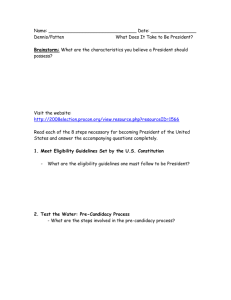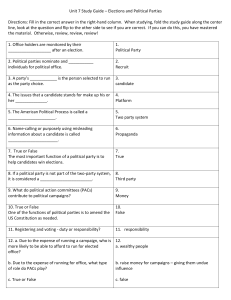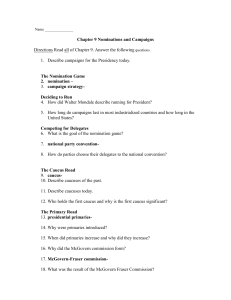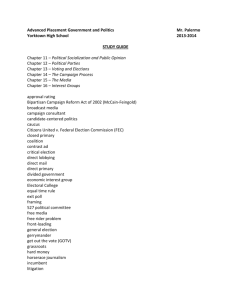Nominations and Campaigns - Mona Shores Public Schools
advertisement
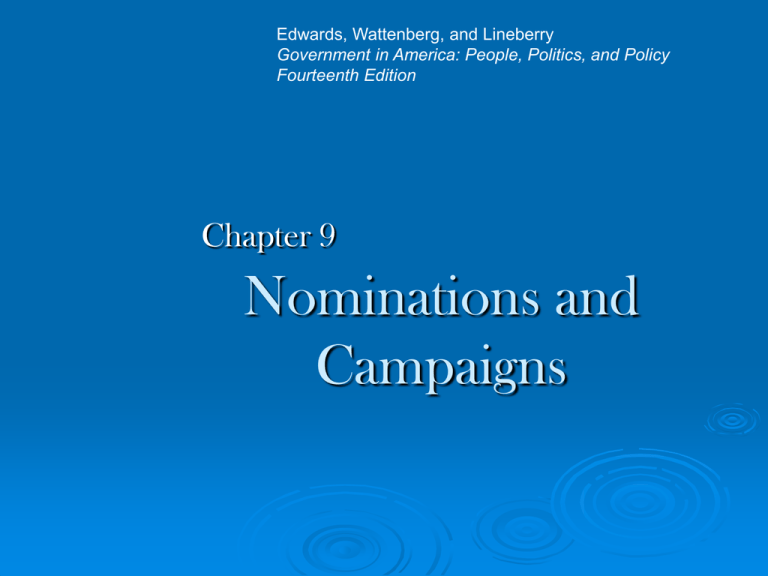
Edwards, Wattenberg, and Lineberry Government in America: People, Politics, and Policy Fourteenth Edition Chapter 9 Nominations and Campaigns The Candidate Centered Campaign (a recent phenomenon) “The Killer Question” What was the “killer question”? Key Terms to know: Campaign strategy Caucus Federal Election Campaign Act of 1974 Federal Election Commission (FEC) Frontloading McGovern-Fraser Commission National Party convention Nomination Party platform Political Action Committee (PAC) Presidential Primaries Soft money Superdelegates 527 Groups Introduction Campaigns then and now Parties less important, media is more important, polling and money matter now more than ever. 2 Distinct Phases: 1. 2. Nomination General Election Opinions on Campaigns "The idea that you can merchandise candidates for high office like breakfast cereal is the ultimate indignity to the democratic process." -Democratic candidate Adlai Stevenson, 1956 "Television is no gimmick, and nobody will ever be elected to major office again without presenting themselves well on it." -Television producer and Nixon campaign consultant Roger Ailes, 1968 The Nomination Game Nomination Generally, success requires momentum, money, and media attention. Goal is to win a majority of delegates’ support at the national party convention, or the supreme power within each of the parties. Campaign Strategy The master game plan candidates lay out to guide their electoral campaign. Good strategies involve extensive polling to discover not only existing attitudes but how to change them. Involves extensive spending on television and time on fund-raising How to win a caucus/primary To win a primary, you must mobilize party activists who will give money, do volunteer work, and attend local caucuses. To get activist support, candidates must move away from the center but during the general election, candidates move towards the center again. Democrats tend to choose those who are not frontrunners while Republicans do the opposite. Primaries/Caucuses an overview of the vote count THE NATIONAL PARTY GIVES A CERTAIN NUMBER OF DELEGATE VOTES TO EACH STATE (similar to electors being allowed to represent each state) THE STATE COUNTS THE VOTE AND SENDS DELEGATES TO THE NATIONAL CONVENTION BY ONE OF TWO FORMULAS: WINNER TAKE ALL…plurality (Republicans) PROPORTIONAL REPRESENTATION (Democrats) Impact of Primary/Caucus System The use of direct primaries instead of the convention system to select presidential candidates has resulted in: 1. a weakening of party control over nominations and an increase in the number of people involved in the choice of candidates. Disproportionate attention to early states. Prominent politicians do not run. Money plays too big a role. Participation in primaries and caucuses is low and unrepresentative; 20 percent vote in primaries. **The affluent are more likely to vote in a presidential primary** The system gives too much power to the media. 2. 3. 4. 5. 6. The Nomination Game The Nomination Game The Convention National conventions once provided great “drama”, but now are a formality, which means less TV time. Significant rallying point for parties Party platform: statement of a party’s goals and policies for next four years The Nomination Game 1968 Democratic Convention – Chicago – A Turning Point • • • George McGovern initiated changes to the rules to prevent another convention disaster Quota for female and minority delegates was established Proportional representation was mandated and a requirement to vote by state rule McGovern Reforms - Democrats con’t Due to the great debate within Democratic party about changes Compromise was made SUPERDELEGATES And sometimes not ! During the 2008 Democratic Primaries, Florida and Michigan were stripped of their delegates by the national party! Impact Reforms to the presidential nomination process have resulted in the number of female delegates and minority-group delegates at Democratic national conventions growing substantially. In 2008 the Superdelegate vote made a difference for the Democrats! Famous Campaign Ads 1964- “The Daisy Girl Ad” 1988- Bush- “Willie Horton Ad”, “Tank Ride”, “Dukakis Response” 2004- “Swiftboat Ads”, “Windsurfing” 2008- “Fundamentals”, “Rearview Mirror” http://www.livingroomcandidate.org/ http://instapunk.com/images/kerry_dukakis_photoops.jpg The Campaign Game Money and Campaigning Campaign finance reforms have attempted to minimize the role of money in influencing the outcome of an election, as was often the case in the past. Federal Election Campaign Act (1974) 1. 2. Created the Federal Election Commission (FEC) to administer campaign finance laws for federal elections Provided partial public financing for presidential primaries 1. Matching funds: Contributions of up to $250 are matched for candidates who meet conditions, such as limiting spending. Also, candidates must raise at least $5000 in each state to get on a ballot. 3. Provided full public financing for major party candidates in the general election 1. $74.4 million for each candidate. 4. Requires full disclosure and limited contributions Money and Campaigning The McCain-Feingold Act (2002) banned soft money, increased amount of individual contributions, and restricted “independent expenditures” Individual limit is $2000 as of 2004. PAC’s can give up to $5000. 527s: independent groups that seek to influence political process but are not subject to contribution restricts because they do not directly seek election of particular candidates Impact of McCain-Feingold (2002) Numerous lawsuits claiming unconstitutional. 2. Shifts power away from corporations and unions and towards the media. 3. The proliferation of PAC’s 1. PACs contributed over $372.1 million to congressional candidates in 2006. Campaigns are more open and honest. 5. Rich are restricted and small donors are encouraged. 6. 527’s are the “loophole” of choice. 4. Landmark Campaign Finance Cases Buckley v. Valeo (1976)- Held that a law limiting contributions to a political campaign's constitutional but restricting a candidate's expenditures of his/her own money was not. McConnell v. Federal Election Commission (2002)upheld McCain-Feingold (2002) which prohibited corporations and labor unions from running ads that mention candidates and their positions 60 days before a general election. More recently… Citizens United vs. Federal Election Commission After reading the article, answer the following questions: 1. 2. 3. What was the Supreme Court’s ruling? What was significant about this decision? What arguments do supporters/opponents of this ruling say? “In he wake of the Supreme Court’s ruling that it’s OK for corporations to contribute to political candidates, I suggest that we require all politicians to wear NASCAR suits-at least we can tell who their sponsors are” -Pat Douglas, Chesterfield, VAStephen Colbert’s “Nacho Cheese Campaign” Money and Campaigning The increased cost of election campaigns has contributed to the decline in trust and confidence in government because: 1. 2. 3. 4. 5. 6. Candidates must spend more time raising money Interest Groups and PAC’s are seen to have too much influence Corporations and connections to wealthy donors Keeps good people from running for office Small contributions seemingly don’t matter Perception that there is wasteful spending. Possible FRQ from Lesson The United States Congress has debated a variety of campaign finance reforms over the last decade. The proposals debated have included the following: Eliminating soft money Limiting independent expenditures Raising limits on individual contributions a) Select on of the listed proposals and do all of the following: Define the proposal. Describe an argument that proponents make in favor of the proposal. Describe an argument that opponents make against the proposal. b) Select a different listed proposal and do all of the following: Define the proposal Describe an argument that proponents make in favor of the proposal Describe an argument that opponents make against the proposal. Assignment With a partner, discuss possible answers to the FRQ on Campaign Finance. Be ready to discuss with the class Recent Proposals 1. Eliminating soft money Arguments in favor include: Arguments against include: •Levels the playing field. •Lessens concern about the undue influence of “buying of influence.” •Provides more disclosure and transparency. •Decreases overall costs of campaigns •First Amendment •Contrary to ruling in Buckley v. Valeo •Weakens political parties. •Might lessen grassroots participation. Recent Proposals Limiting Independent expenditures Definition: Limiting money spent by individuals and groups not directly affiliated with the candidate or the party 2. Arguments in favor include: Arguments against include: •Levels the playing field. •Possibly reduces negative issue ads. •Candidates want to control their own campaigns. •Lessens concern about undue influence of buying of influence. •First Amendment •Contrary to ruling in Buckley v. Valeo. •Might lessen grassroots participation. Recent Proposals 3. Raising limits on individual contributions Definition: Increasing the dollar amount individuals may give to a campaign, parties, or PAC’s Arguments in favor include: Arguments against include: •Limits are not indexed to inflation. •Candidates can spend less time fundraising •Decreased the influence of PAC’s •Decreased restrictions on First Amendment rights. •Allows the rich to have/buy more influence •Too much money in the process already. •Drives up the cost of campaigns.
